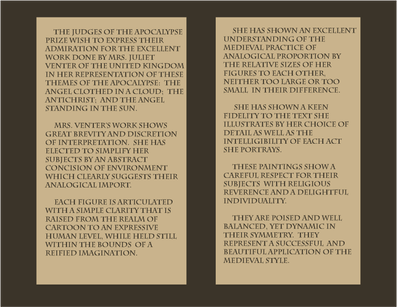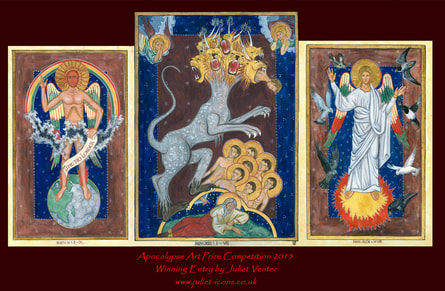Apocalypse Art Prize Competition USA 2015 - Winner
About my entry
June 2016
When I entered my illuminated triptych into the Apocalypse Art Prize offered in the USA at the end of last year it was simply as a challenging exercise and I didn’t really have any notion of winning. The results were announced on 1 June 2016. The requirements for the composition were specific and strict and needed some thought to fulfill, but for my interests and preferred media the project was tailor-made. There are very few forums which celebrate the traditional arts, never mind Christian art. I completed the entry over six months between commissions and other work, and blogged about the unaccustomed horrors of working on paper (here). I found the prescribed minimum dimensions uncomfortably large for techniques of manuscript illumination, but since the initial submission was to be online the piece had to be big enough to be studied at screen resolution.
The criterion for awarding prizes was as follows: ”Each prize will be awarded to the participating artist who is best able to use the analogical painting language of the Middle Ages in his own work.” The contest is administered in the USA by Gloria Thomas, a distinguished Catholic artist (website here), together with a panel of judges, and is funded by the generosity of a private benefactor. Due perhaps to a misunderstanding arising from the title, the competition apparently drew a lot of attention from fantasy art enthusiasts, but the judges were looking for work that sat within the referential tradition of Christian art. It may not be always obvious at a glance, but up to the contemporary period medieval illumination and Christian art and architecture in general have always been underpinned by the principles of composition and symbolic use of geometric forms referred to in shorthand as ‘sacred geometry’ . It is this geometry that, I hope, makes my triptych a unified whole. In fact I would have preferred to go further by uniting the three panels in a single architectural frame, but the necessity of keeping within sensible size restrictions for airmail posting made that plan infeasible.
The three subjects had to be chosen from the Apocalypse of John, or Book of Revelation, divided for the purposes of the contest into three sections. My first choice was a no-brainer, sprang fully armed from my head, and is a good demonstration of the principle I am trying to put into practice of not wasting work. This is the angel who announces the end of time and the onset of the last days in Chapter 10. I have been fascinated with the poetry of this passage since I read Tom’s Midnight Garden as a child. As a young recruit in the Girl’s Brigade I probably shocked our leaders by lugubriously reciting the passage by heart, together with the obligatory 23rd Psalm, as my ten Bible verses of choice for the Bible Knowledge badge. They were probably expecting the Beatitudes or the hymn to love from Corinthians. My angel clothed in a cloud has already had a previous incarnation in a huge embroidered wall hanging which I made for lofty staircase about fifteen years ago. My young daughter was kind enough to say “Oh Mummy, you do beautiful sewing!”, but I had to retire it because she found it too scary.
The other panels of the triptych I found more of a challenge to choose. Panel three, the angel standing in the sun, made a counterpoint to the first fearsome fellow. He calls down the birds to cleanse the earth after the great battle. I emphasised his more beatific aspect and did not (unlike most medieval manuscripts) represent the dead and dismembered bodies they come down to feast on. The central panel, with John on Patmos dreaming the whole vision, is a literal portrayal of the Beast who makes war on the saints: he had seven heads, I forget how many horns and diadems, feet of a bear, head of a lion, body of a leopard and so forth.. The faithful are helpless against his temporary triumph. In medieval manuscripts they tend to be rushing in with bows and arrows, spears, swords and trebuchets. But I decided to represent them trampled, pale and lifeless, emblematic of spiritual apathy and despair in the modern age.
In all, the composition was entirely my own invention but the panel format and colour scheme I cheerfully swiped from the Trinity Apocalypse. This is a priceless example of English Art, produced around 1250 and now in the library of Trinity College Cambridge, just down the road from where I live.
The prize of seven thousand dollars, which worked out to be just shy of five thousand pounds, is a tangible and most welcome piece of encouragement and recognition to me. I have already celebrated by ordering some rare quality and coveted pigments from Attila at MasterPigments.com - his cinnabar, caput mortuum, volksonkoite and vivianite - which I shall reserve for ‘special’. I also plan to use a tithe of the money to create a large multiple-figure altar piece which I have been cogitating for some time. For the rest, maybe keep it for travel and study, maybe use it to fit out a new little studio when we next relocate.
The criterion for awarding prizes was as follows: ”Each prize will be awarded to the participating artist who is best able to use the analogical painting language of the Middle Ages in his own work.” The contest is administered in the USA by Gloria Thomas, a distinguished Catholic artist (website here), together with a panel of judges, and is funded by the generosity of a private benefactor. Due perhaps to a misunderstanding arising from the title, the competition apparently drew a lot of attention from fantasy art enthusiasts, but the judges were looking for work that sat within the referential tradition of Christian art. It may not be always obvious at a glance, but up to the contemporary period medieval illumination and Christian art and architecture in general have always been underpinned by the principles of composition and symbolic use of geometric forms referred to in shorthand as ‘sacred geometry’ . It is this geometry that, I hope, makes my triptych a unified whole. In fact I would have preferred to go further by uniting the three panels in a single architectural frame, but the necessity of keeping within sensible size restrictions for airmail posting made that plan infeasible.
The three subjects had to be chosen from the Apocalypse of John, or Book of Revelation, divided for the purposes of the contest into three sections. My first choice was a no-brainer, sprang fully armed from my head, and is a good demonstration of the principle I am trying to put into practice of not wasting work. This is the angel who announces the end of time and the onset of the last days in Chapter 10. I have been fascinated with the poetry of this passage since I read Tom’s Midnight Garden as a child. As a young recruit in the Girl’s Brigade I probably shocked our leaders by lugubriously reciting the passage by heart, together with the obligatory 23rd Psalm, as my ten Bible verses of choice for the Bible Knowledge badge. They were probably expecting the Beatitudes or the hymn to love from Corinthians. My angel clothed in a cloud has already had a previous incarnation in a huge embroidered wall hanging which I made for lofty staircase about fifteen years ago. My young daughter was kind enough to say “Oh Mummy, you do beautiful sewing!”, but I had to retire it because she found it too scary.
The other panels of the triptych I found more of a challenge to choose. Panel three, the angel standing in the sun, made a counterpoint to the first fearsome fellow. He calls down the birds to cleanse the earth after the great battle. I emphasised his more beatific aspect and did not (unlike most medieval manuscripts) represent the dead and dismembered bodies they come down to feast on. The central panel, with John on Patmos dreaming the whole vision, is a literal portrayal of the Beast who makes war on the saints: he had seven heads, I forget how many horns and diadems, feet of a bear, head of a lion, body of a leopard and so forth.. The faithful are helpless against his temporary triumph. In medieval manuscripts they tend to be rushing in with bows and arrows, spears, swords and trebuchets. But I decided to represent them trampled, pale and lifeless, emblematic of spiritual apathy and despair in the modern age.
In all, the composition was entirely my own invention but the panel format and colour scheme I cheerfully swiped from the Trinity Apocalypse. This is a priceless example of English Art, produced around 1250 and now in the library of Trinity College Cambridge, just down the road from where I live.
The prize of seven thousand dollars, which worked out to be just shy of five thousand pounds, is a tangible and most welcome piece of encouragement and recognition to me. I have already celebrated by ordering some rare quality and coveted pigments from Attila at MasterPigments.com - his cinnabar, caput mortuum, volksonkoite and vivianite - which I shall reserve for ‘special’. I also plan to use a tithe of the money to create a large multiple-figure altar piece which I have been cogitating for some time. For the rest, maybe keep it for travel and study, maybe use it to fit out a new little studio when we next relocate.

